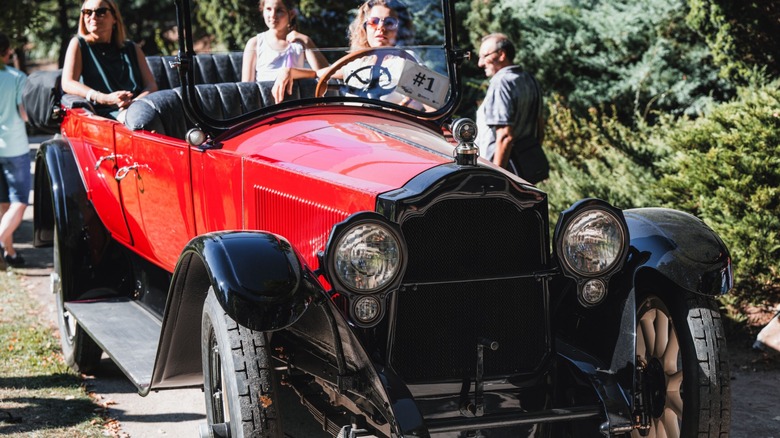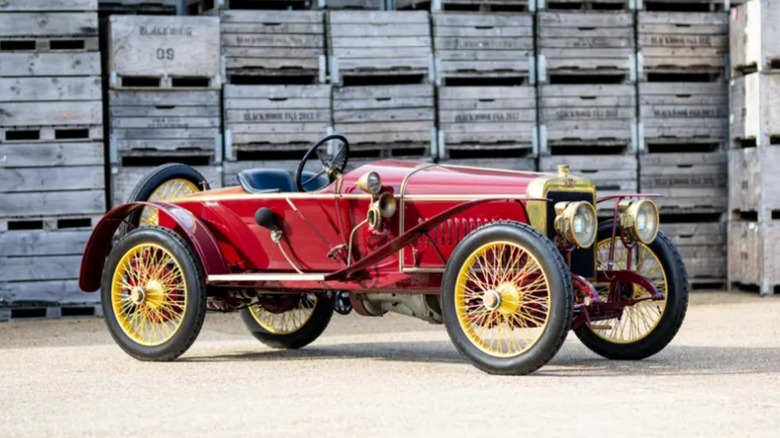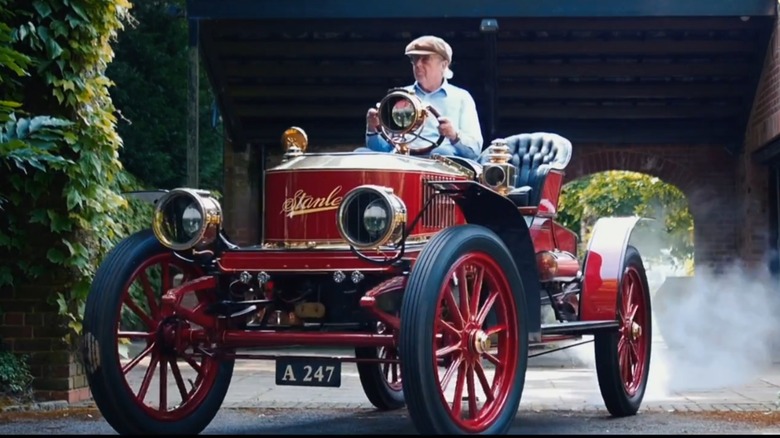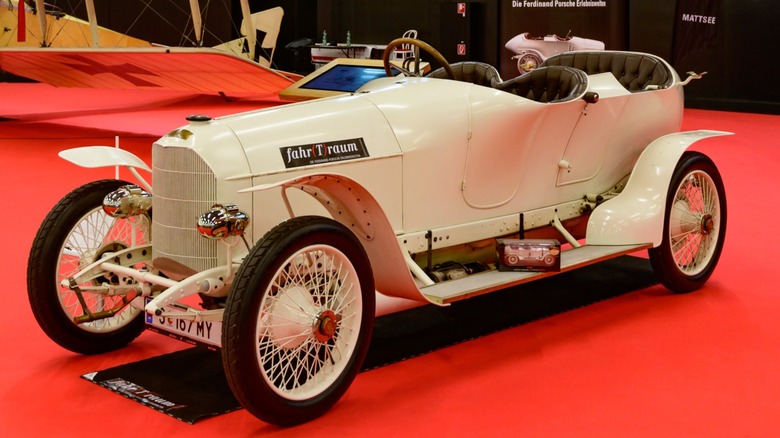7 Of The Fastest Production Cars Built During The Brass Era
Covering the earliest years of the automobile from roughly 1895 to 1915, the Brass Era was a time of discovery and innovation when nobody had a blueprint for what a car should or could be. Nobody knew the limits of technology and engineering and even the understanding of the physics of automobile travel remained primitive. Yet, through trial and error matched with the sheer force of will, an agglomeration of people on multiple continents forced ideas from their minds to mold rubber and steel in the quest for speed.
The Brass Era is named for the copious amounts of brass fitted to the cars as gas headlamps, handles, switches, horns, radiator caps, and just about any other surface that would benefit from a gleaming brass hue. Practical nickel plating came along in 1916, signaling the end of the era. The cars of this era display some of the finest craftsmanship ever to have come from the industrial revolution, and almost all cars were hand-built individually. Even though only the wealthy could afford an automobile, hundreds of companies tried to cash in on the trend, most of which failed.
Despite the limited technology, talented engineers pushed past boundaries of what was thought possible, creating increasingly powerful and fascinating machines, upping the brinkmanship with each model. While most early cars were built for practicality, some were built for performance. These Brass Era cars offered excellent power capable of extraordinary top speeds.
1911 Mercer Raceabout
If the Chevrolet Corvette C8 represents the pinnacle of American high-performance automobile manufacturing today, the Mercer Raceabout could be roughly considered its equivalent of the Brass Era. Originally set on production of a moderately priced car for mass appeal, Mercer employed at least a few gifted individuals who would push the company to build a high-performing speedster.
After a couple of prototypes and continued development, they built the Type 35-R Raceabout. Powering this car was an engine created by engineer Finley Robertson Porter featuring many specifications that would be seen on high-performance engines today. The 4-cylinder t-head engine set two sets of paired cylinders atop an aluminum crankcase housing a forged steel crankshaft and connecting rods, all balanced and precision engineered to within .001-inch tolerance.
The Raceabout sat very low to the ground, and its 58-horsepower engine gave it a top speed of 70 mph, nearly double that of most cars of the day. Furthermore, Mercer installed heavy-duty parts to withstand the intense rigor of high-speed driving, such as shaft drive instead of the more common chain and stacked steel clutch plates in place of the leather cone type. In addition to handling a constant 60 mph, the Raceabout handled well with precise steering and a manageable gearbox. These reasons and more make it famous and desirable, selling for upwards of $5 million today.
1912 Stutz Bearcat
For some, the name Stutz conjures up the image of a large and lavishly styled luxury 1970s coupe known to be nothing more than a gussied-up Pontiac. These were extraordinarily expensive coach-built cars that were among the rarest cars owned by Elvis Presley and Frank Sinatra alike, but Stutz predates them by decades.
Harry Stutz in 1911 developed and built a car himself in just five weeks to run in the inaugural Indianapolis 500 Mile Race, placing 11th out of 22, earning it the slogan "The Car That Made Good in a Day." It performed so well that a detuned version for the road went on sale almost immediately after. Initially powered by a Wisconsin T-head 4-cylinder engine of 390 cubic inches, the Bearcat output of 60 horsepower was enough for a top speed of 80 mph, quite respectable in 1912.
Stutz designed a new engine soon after production began, creating a 360-cubic-inch 4-cylinder with four valves per cylinder. This engine displaced 360 cubic inches but brought output up to 83 horsepower. The Bearcat was such a fast and well-built car, Erwin "Cannon Ball" Baker drove one from Los Angeles to New York City in 11 days, 7 hours, and 15 minutes, breaking a record and serving as an inspiration for the cross-country race and Cannonball Run movies decades later.
1912 Peerless Model 60 Runabout
The Peerless Motor Car Co. originated at the dawn of the 20th century, quickly becoming known for making some of the most opulent motor cars available in their day. Pricing of a Peerless in 1905 ran from $3,000 to $6,000, or about the cost to buy up to two luxury homes. In addition to cars of luxury, Peerless put its innovation to use for performance, making cars for sporting gentlemen who enjoyed racing, which has always been a rich man's game.
Peerless was a member of the three Ps making up the triumvirate of American luxury cars with Packard and Pierce-Arrow. All three companies produced generously powerful engines from 1910, but Peerless and Pierce-Arrow got a bit carried away. The latter in 1910 made a move by releasing a giant 800-cubic-inch engine producing 66 horsepower and beating the contemporary Bugatti Royale in displacement. Not content to sit back and watch, Peerless raised the bar with a new 825-cubic-inch behemoth of its own in 1912.
The giant 13-liter straight-6 engine may have only produced 60 horsepower, but with the amount of weight moving in such a large engine, its torque would be off the chart. Its size is so large, no American manufacturer has installed anything larger in a production car since. Top speed ratings are not published, but it should be safe to assume this one would be as fast or faster than anything else made in 1912.
1915 Packard Twin Six
By 1900, what would become the Packard Motor Car Company, one of America's premier pre-war luxury automakers, was already introducing its second model for sale. Given this early start in the industry, Packard was at the forefront of emerging technologies and became known for innovation as much as for catering to wealthy buyers. This led not only to building cars of a certain caliber for passengers, but also for building cars that performed.
Through 1915, Packard had staked its reputation on well-built 6-cylinder engines that provided ample power for its sometimes very large vehicles. But when Cadillac introduced its first V8 in 1915, Packard had to respond. The response was the first production V12 ever sold in a passenger car, which Packard dubbed the Twin Six. The new engine displaced 421 cubicbinches with a 60-degree V that kept it compact and comparatively light. Running at 3,000 rpm, the V12 delivered 88 horsepower, and while no figure is published, the torque was likely immense. And with such smooth and gracefully balanced power available to drivers, cruising comfortably at 60 mph in a 1915 Packard was no problem. Top speed was about 75 mph.
1913 Hispano-Suiza Alfonso XIII
In an atypical international business partnership between principals from Spain and Switzerland, the automaker Hispano-Suiza built cars in Barcelona using Spanish capital with Swiss engineering. The company struggled in the beginning, but when it received support from the Spanish king along with a substantial order, its outlook improved and became a maker of some of the finest automobiles of its time.
King Alfonso XIII of Spain boosted Hispano-Suiza not only to promote the products of a Spanish company, he was also an auto enthusiast who eventually acquired an 8% share of the company. The automaker became a builder of some of the most opulent cars ever made, but most of them were built after WWI, to which the company contributed tens of thousands of V8 aircraft engines, concluded. Before the war, it produced the Hispano-Suiza T15, aka the Alfonso XIII.
Built as a lightweight two-seater, the T15 could be considered one of the first European sports cars. Powered by a 4.7-liter 4-cylinder T-head engine producing about 60 horsepower. Unlike the many race cars transformed for road use at the time, this was purpose-built as a high-speed production car available for sale that could do 75 mph as delivered, but a racing tune could edge that up to 90. Its rarity and sporting credentials have kept its value high throughout the decades — one sold very recently by Sotheby's in the United Kingdom for £263,750 (about $334,322).
1907 Stanley Semi-Racer Model K
The internal combustion engine and its use of gasoline spurred the explosion of the auto industry in the late 19th century, but it was not the only game in town. Indeed, before the turn of the century, the Baker Motor Vehicle Company began making electric cars while others were powered by external combustion engines, aka steam engines.
Also birthed in the 1890s was the Stanley Motor Carriage Co., which built cars powered by steam engines. Equipped with a boiler full of water and a burner with kerosene or gasoline to heat it — that's the external combustion — steam was produced to provide the pressure needed to run the engine. An old technology by 1900, the steam engines of Stanley's cars, known as Stanley Steamers, made relatively low power but tremendous amounts of torque.
In 1907, Stanley created a streamlined car to set a world speed record, reaching 127.66 mph in 1906. Buoyed by its success, Stanley created a lightweight three-passenger car it called a "semi-racer" using a smaller version of the boiler in the speed record car initially and installed the full 30-horsepower unit by 1908. Overall, 26 were made through 1910. A Model K cruises at 60 mph without breaking a sweat, and a 30-horsepower Stanley sold by Bonhams in 2021 hit 90 mph up a 15% grade in 1997 at the HCCA Dead Horse hill climb race in Worcester, Massachusetts. No doubt that with the extreme torque of the steam engine of up to 800 lb-ft, its speed could have gone much higher.
1905 FIAT 60 HP
With nearly 125 years of automobile production under its belt, Fiat continues manufacturing today as one of the oldest automakers on the planet. Founded midway through 1899, production commenced shortly thereafter, and not only did the company rapidly scale up production, including expanding into industrial and marine vehicles in 1903, it entered a car into motorsports in 1899 with the Fiat "Welleyes" 4 horsepower model.
By 1905, Fiat showed signs of phenomenal growth and was already on its way to establishing itself as a premier automaker, with racing victories bolstering its reputation. This is the same year Fiat released its 60 HP, a versatile chassis featuring a massive 10.6-liter 4-cylinder engine with an output of 60 horsepower. Considering cars of this time typically were more like a 1905 Buick Model C, which made just 22 horsepower, the Fiat output was substantial and the massive engine likely produced an amazing level of torque. Nevertheless, this was never expressly built as a performance car.
Fiat only made about 20 of these cars in total, all for the extremely wealthy. For example, St. Louis brewery scion August Anheuser Busch Sr. had one built with the finest detail and craftsmanship possible for about $18,000, the cost of a new house many times over in 1905. Sotheby's sold it in 2014 for $825,000, actually beating more than a century of inflation. While its top speed is not officially published, rumors of it reaching 60 mph are completely within reason.
Austro-Daimler 27/80 Prince Henry
While few might know of it today, the Austrian automaker Austro-Daimler played a prominent role in central European industry after its founding in 1899. While separate from Daimler-Benz AG, parent company of today's Mercedes-Benz luxury automaker, its founder, Paul Daimler is the grandson of Gottlieb Daimler, namesake of Daimler-Benz AG. Furthermore, Ferdinand Porsche became the company's technical designer in 1902. It was a subsidiary of Daimler-Motoren-Gesellschaft, predecessor of the modern Mercedes-Benz company until 1934.
Austro-Daimler was a major manufacturer of trucks, buses, airship and marine engines, and automobiles, including luxury and high-performance models. Among the powerful cars by Austro-Daimler is the 27/80 Prince Henry, designed by Ferdinand Porsche, who also created one of the earliest known hybrids in 1900. Known to be among the world's first sports cars, it featured a 5.7-liter overhead cam 4-cylinder engine said to produce up to 95 horsepower. It used large valves and lighter pistons for greater power while relying on a total loss oil system. Capable of hitting 90 mph, it proved to be not just fast, but also reliable, winning first, second, and third in the Prince Henry Tour for which it is named.
The years after WWI proved to be tumultuous to many central European companies, and Austro-Daimler ended up being folded into another Austrian concern, Puch. However, the man responsible for its illustrious cars, Ferdinand Porsche, went on to other less illustrious things, such as creating the Volkswagen Type 1.








